WORKS FOR SALE
A PAIR OF GEORGE II WALNUT AND BURR WALNUT ARMCHAIRS
W: 84 cm
D: 67.5 cm
Further images
-
(View a larger image of thumbnail 1
)
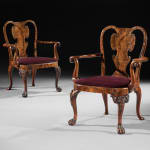
-
(View a larger image of thumbnail 2
)
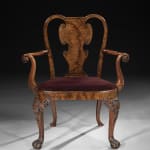
-
(View a larger image of thumbnail 3
)
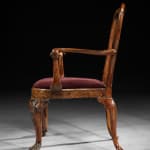
-
(View a larger image of thumbnail 4
)
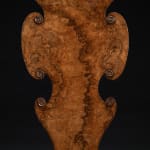
-
(View a larger image of thumbnail 5
)
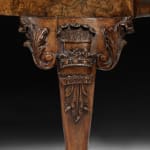
-
(View a larger image of thumbnail 6
)
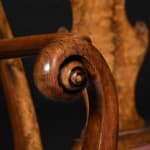
-
(View a larger image of thumbnail 7
)
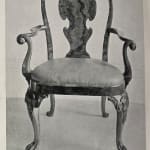
-
(View a larger image of thumbnail 8
)
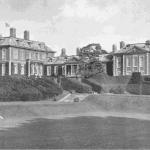
Provenance
Part of the suite of six armchairs and fifteen side chairs supplied to either Sir Philip Astley (1667-1739), 2nd Bt. or Sir Jacob Astley (1691-1760), 3rd Bt. for Melton Constable Hall, Norfolk
By descent at Melton Constable with the Astley baronets and later the Barons Hastings until 1948, when the chairs were acquired with the house
Sold Christie’s, London, 23 April 1998, lot 30, GBP 194,000
The William F. Reilly Collection, New York, USA
Sold Christie’s, New York, 14 October 2009, lot 115, estimate: USD 250,000 - 400,000
Private Collection, California, USA
Literature
‘Melton Constable, Norfolk’, Country Life (16th September 1905), pp. 378-84
Hussey, C., ‘Melton Constable, Norfolk – I & II’, Country Life (15th & 22nd September 1928), pp. 764–70, 402-9
COMPARE
A pair of walnut armchairs of similar form sold Christie’s, New York, 16th April 2002, Lot 155, USD $196,500
Publications
Hussey, C., ‘Needlework Furniture at Melton Constable’, Country Life (6th October 1928), p. 480, fig. 6
DOCUMENTATION
The present chairs and suite recorded in the surviving inventories of 1799, 1860 and 1901 of Melton Constable Hall, see Harding, G. and H., Catalogue of the Ornamental Furniture, Works of Art, and Porcelain, at Melton Constable Hall, Norfolk (London, 1901), p. 8
A pair of armchairs of carved walnut, the classical vase-shaped splats veneered with richly figured burr walnut, carved with roundels between similarly veneered shaped uprights; the serpentine armrests and supports issuing boldly carved scrolls above veneered seat rails with drop-in seats; the elegant back legs ending in pad feet and the cabriole front legs headed with the Astley family crest of five ostrich feathers issued from a ducal coronet flanked by acanthus leaves and terminating in hairy paw feet.
The suite of chairs supplied to Melton Constable Hall, Norfolk is one of the great suites of walnut seat furniture produced in the eighteenth century.1
Replete with antique ornament and carved with the heraldic device, the chairs underscore the ancient lineage of the Astleys. The recognised founder of the family fortunes, Sir Thomas de Astley (1215-65) of Astley Castle and Hillmorton, Warwickshire, summoned to Parliament as Baron Astley in 1253, was killed at the battle of Evesham in 1265. He acquired the estate of Melton Constable by his second marriage in 1236 to Editha, daughter and heiress of Peter Constable of Melton Constable.
Though the possession of the Astleys since the early thirteenth century, the present manor of Melton Constable was built from 1664 by Sir Jacob Astley (1640-1729), 1st Bt. His Carolean house – for he likely acted as his own architect – is one of the most important of its date in the country, part of the small group of fine mid-late seventeenth-century houses comprising Coleshill, Kingston Lacy, Clarendon, Stoke Edith and Belton that exemplifies this distinctively English style, a legacy of Inigo Jones and developed by Roger Pratt, called the only truly English vernacular style of architecture to have developed since the Tudor period.2
The present chairs were made for the Eating Room, now the Red Drawing Room, of the present Melton Constable Hall. The spectacular plaster ceiling, dated 1687, bears the quartered arms of the family’s founder, Sir Thomas, placed by the first baronet in the pediment of the south front, as well as the same baronet’s cypher and singular crest of five feathers rising from a ducal coronet which, some fifty years later, was repeated on the knees of the present chairs, as it was again in the pediment of the connecting Gallery, built by the fifth baronet in 1810. The ceiling also features panels of boldly modelled game-birds, partridges and pheasants, flowers, bunches of grapes and other fruit, reflecting the original function of the room.3
The chairs were likely made for another Jacob, later the third baronet, who in his father’s old age probably oversaw the refurbishments of the 1730s when these chairs were made. He was a keen musician. Sir Jacob is depicted playing the cello in a group portrait of 1734 by Heins of Norwich which may capture the original interior of the Chapel, which he converted into the Saloon. In 1721 he married Lucy, the sister and coheiress of Sir Henry le Strange of Hunstanton, which brought to the Astleys the claim to the ancient barony of Hastings, sub sequently revived in their favour, and which had, in fact, been created in 1264 by writ from Sir Simon de Montfort, the man with whom the family founder Sir Thomas sided at Evesham in 1265.
Jacob’s namesake was his ancestor the first Sir Jacob Astley (1579-1653), later 1st Baron Astley of Reading, the famous cavalier; but before him the family achieved prominence at the Tudor court as relations of the Boleyns and favourites of Elizabeth I. Jacob the builder met Charles II on his landing in 1660 and marched into London as his Royal Standard Bearer. He began the family Commons tradition which lasted until the the fifth baronet who inherited the Seaton Delaval estate and the great Vanburgh house with it, where the family lived on as the Barons Hastings.
The chairs reflect the grandeur of the English classical tradition. Roman acanthus leaves flank each ducal coronet, the splats take the shape of classical vases, and the legs terminate in hairy lion’s paws, celebrating the great Bacchus, Roman god of wine and revelry, who was often depicted riding wild cats in reliefs and other iconography. A stylistic tour de force, these chairs encapsulate not only the history of the Astley family, but to a significant degree that of England itself.
1 Recorded in the inventories of 1799, 1860 and 1901, see Harding, G. and H., Catalogue of the Ornamental Furniture, Works of Art, and Porcelain, at Melton Constable Hall (London, 1901), p. 8
2 N. Kingsley, Landed families of Britain and Ireland, ‘Astley of Melton Constable’ (18 June 2016)
3 ‘Melton Constable, Norfolk’, Country Life (16 September 1905), pp. 378-84; C. Hussey, ‘Melton Constable, Norfolk – I & II’, Country Life (15 & 22 September 1928), pp. 764–70; pp. 402-9







